Holly Thompson's Blog, page 8
April 26, 2019
Cooking up Poems!
I've taught creative writing in Japan for twenty years now, and I've learned that poetry writing is a vital experience for English language learners.
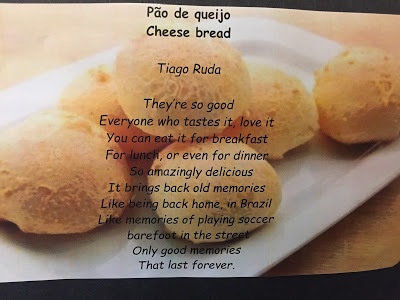
In university classes and in author visits to elementary, middle and high schools, I sometimes focus poetry sessions on food and narrative. I share excerpts from verse novels in which food is woven into scenes. I share short poems and longer poems--by poets like Naomi Shihab Nye, Richard Blanco, Misuzu Kaneko, Janet Wong, Li-Young Lee, Kobayashi Issa and others. And together we brainstorm foods associated with memories, foods connected to experience or place, foods that offer up conflict that leads to story, and foods of our cultures and identities.
I share some of my food poems including "Defeated" and my video poem "Kaki-no-Tane."
I point teachers to this wonderful Teachers & Writers Magazine piece "Food Themed Poetry with Refugee and Immigrant Students" by Merna Ann Hecht.
And we get to work. This school year, I was privileged to visit the same Massachusetts high school twice--in the fall to begin work on food poems with ELL students and this spring to cook up our poems together.

The poems were completed and posted on a poetry wall after my first meeting with the students, and an April date was set for cooking up our poems with the cooking and ELL teachers.
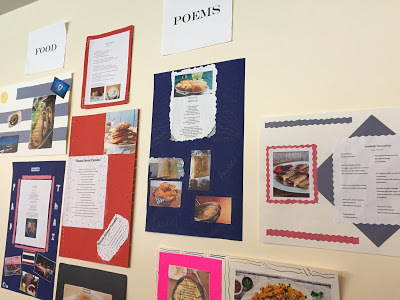
I cooked up some wakame miso soup . . .
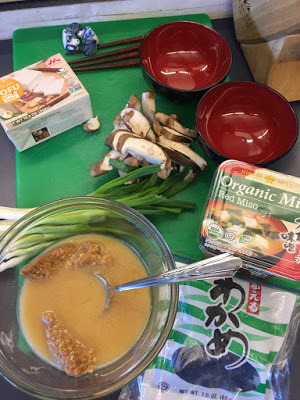
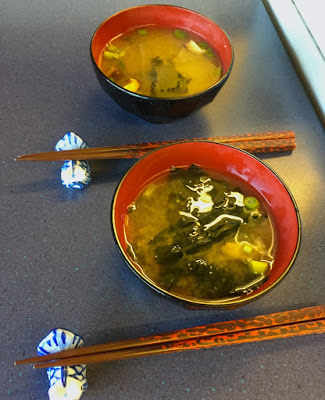
. . . and the students from Brazil, Ethiopia, Colombia and Thailand, plus the teacher from Sweden--along with the cooking teacher's help and the librarian's cheerleading--made their dishes

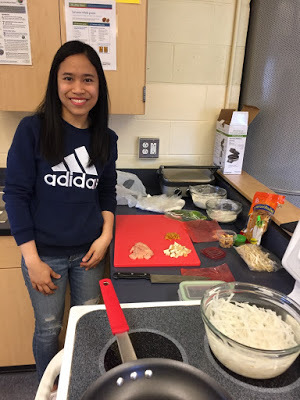
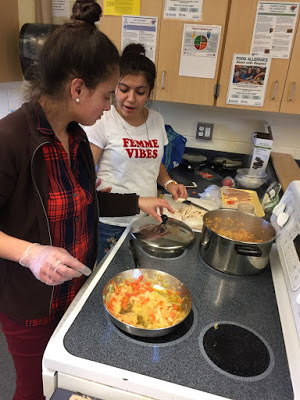
and together we served up an amazing lunch!
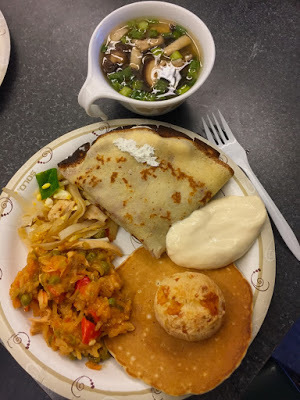

Thank you, students and teachers! What a joy to join you all for this Cooking up Poems project!

In university classes and in author visits to elementary, middle and high schools, I sometimes focus poetry sessions on food and narrative. I share excerpts from verse novels in which food is woven into scenes. I share short poems and longer poems--by poets like Naomi Shihab Nye, Richard Blanco, Misuzu Kaneko, Janet Wong, Li-Young Lee, Kobayashi Issa and others. And together we brainstorm foods associated with memories, foods connected to experience or place, foods that offer up conflict that leads to story, and foods of our cultures and identities.
I share some of my food poems including "Defeated" and my video poem "Kaki-no-Tane."
Defeated
Oyakodon (Chicken and Egg Bowl) 親子丼https://www.justonecookbook.com/oyakodon/after I argue with my motherand lose
she serves myfavorite oyakodon for dinner
chicken and eggparent and childtogether on rice
which is impossibleto eat and still feel angry
© Holly Thompson All Rights Reserved
I point teachers to this wonderful Teachers & Writers Magazine piece "Food Themed Poetry with Refugee and Immigrant Students" by Merna Ann Hecht.
And we get to work. This school year, I was privileged to visit the same Massachusetts high school twice--in the fall to begin work on food poems with ELL students and this spring to cook up our poems together.

The poems were completed and posted on a poetry wall after my first meeting with the students, and an April date was set for cooking up our poems with the cooking and ELL teachers.

I cooked up some wakame miso soup . . .


. . . and the students from Brazil, Ethiopia, Colombia and Thailand, plus the teacher from Sweden--along with the cooking teacher's help and the librarian's cheerleading--made their dishes



and together we served up an amazing lunch!


Thank you, students and teachers! What a joy to join you all for this Cooking up Poems project!
Published on April 26, 2019 10:44
December 31, 2018
Tomo Anthology Year-End Donations
On this December 31, I'm happy to report that Tomo: Friendship Through Fiction--An Anthology of Japan Teen Stories published in 2011 by Stone Bridge Press continues to raise funds for teens in Tohoku areas affected by the 2011 earthquake and tsunami. Nearly seven years after publication, funds are still generated by this anthology that I compiled and edited in the months soon after the 3/11 disaster.
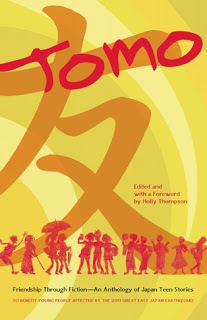
This December publisher Peter Goodman of Stone Bridge Press made a generous Tomo donation to the NPO TEDIC, based in Ishinomaki, and today I followed with a Tomo donation to the NPO Sokoage, based in Kesennuma.
Read details in the full post Tomo 2018 Year-End Donations on the Tomo Anthology blog.
I wish everyone sweet hatsuyume dreams of eggplants, hawks and Mt. Fuji (all considered auspicious if sighted in dreams on January 1) and hope that the New Year brings peace and joy and the promise of bright futures to young people throughout the Tohoku region.
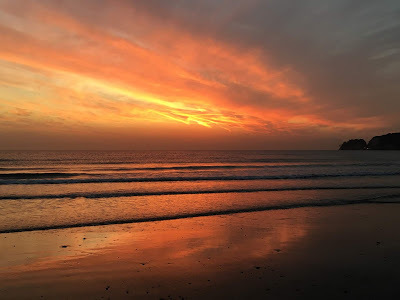

This December publisher Peter Goodman of Stone Bridge Press made a generous Tomo donation to the NPO TEDIC, based in Ishinomaki, and today I followed with a Tomo donation to the NPO Sokoage, based in Kesennuma.
Read details in the full post Tomo 2018 Year-End Donations on the Tomo Anthology blog.
I wish everyone sweet hatsuyume dreams of eggplants, hawks and Mt. Fuji (all considered auspicious if sighted in dreams on January 1) and hope that the New Year brings peace and joy and the promise of bright futures to young people throughout the Tohoku region.

Published on December 31, 2018 00:20
December 30, 2018
SEVENTEEN and That Summer of 1985
I was eager yet hesitant to read Hideo Yokoyama's 2006 novel クライマーズ・ハイ(Climber's high) recently translated from Japanese by Louise Heal Kawai and released in English in 2018 as
Seventeen
. I knew it would churn up memories.
 One novel, three covers, from left: クライマーズ・ハイ(Japan edition); Seventeen covers for two English editions
One novel, three covers, from left: クライマーズ・ハイ(Japan edition); Seventeen covers for two English editions
This is the descriptive copy for Seventeen:
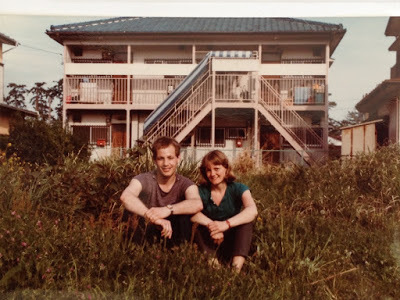
We both taught English in Japanese high schools, and we'd signed on for a third year, but that summer of 1985 my husband's 18-year-old brother was dying of renal cancer back in Ohio. We'd learned in May, just two months after he'd traveled to Japan to visit us, that he likely only had a few months but would undergo treatment hoping for more time.
Our students and colleagues in Japan helped fold senbazuru--1,000 paper cranes. My husband traveled home during a week when, incredibly, his brother was well enough to be up and about. Soon after my husband returned to Japan though, his brother's condition deteriorated.
We waited out the time thousands of miles away. The distance from family in the U.S. was painful--letters and our expensive landline were our only means of connection. We leaned on Japanese friends and fellow teachers for support. When the end came in early August, we were in Kyushu at the home of my husband's best friend from his time living in Kyoto. We went outside, looked up at the stars in the dark Kagoshima night and wept. The world seemed changed.
My parents were also visiting that summer. Before we'd visited Kyushu, I'd taken them north to Urabandai, and while there, my father shared that he had been diagnosed with Parkinson's disease. The weight of this upsetting news added to the burden of family grief I was lugging around that summer.
We left Kyushu and returned to Fujisawa. My parents left Japan on August 11, just before Obon. Then on August 12, Japan Airlines flight 123 crashed into a mountain in Gunma. We were glued to the TV and newspapers as the immensity of the disaster unfolded: rescue crews waiting to reach the crash site until the following day; 520 dead, just 4 survivors; one surviving girl being airlifted from the wreckage; the discoveries of last messages written by passengers as the plane descended . . .
This national grief, which blended with the other losses of that summer, inevitably and ultimately wove its way into my fiction writing. My novel Ash is set during the summer of 1985 in Kagoshima and Kyoto; protagonist Caitlin is coping with unresolved grief from a loss experienced as a child in Kyoto.

For me, reading Seventeen, with the JAL 123 crash as the central event of the story, was a complicated experience. I wanted to focus on the the layers of the various subplots--protagonist Yuuki's newsroom dramas, family conflicts, the mountain climbing experiences, but I came to full stops whenever details of the crash were described. The novel catapulted me right into that summer of 1985, and I had to pause, catch my breath, to reprocess the multiple layers of events that had been happening in my own life at that time, as well as the words of Yokoyama's novel.
During that summer of 1985, bicycling back from the train station to our Fujisawa apartment, I'd find myself pedaling as fast as I could on my mamachari, seeking the blur of speed to beat the grief relentlessly following me. Seventeen took me back to that summer and fall--pedaling madly down back lanes, along the river, out to the soothing Shonan shore.
Seventeen is a complex, compelling story played out within a local newsroom as protagonist Yuuki's work becomes all absorbing when the unimaginable JAL flight 123 disaster happens nearby. It's a story of stressful newsroom dynamics, vexing distances within home and family, of the perils of negotiating friendship and loss, of acknowledging regret, love and fear. Mountain climbing provides additional mystery and relief from the high-stakes newsroom drama and effectively ropes the chapters together.
Louise Heal Kawai did a beautiful job with the translation; see her post On the Challenges of Translating Seventeen. And see this Los Angeles Review of Books review.
Now that I've had some time to re-process 1985, I look forward to re-reading Seventeen and making fewer stops along the way to catch my breath.
 One novel, three covers, from left: クライマーズ・ハイ(Japan edition); Seventeen covers for two English editions
One novel, three covers, from left: クライマーズ・ハイ(Japan edition); Seventeen covers for two English editionsThis is the descriptive copy for Seventeen:
A tense, powerful thriller from the bestselling author of Six FourIn 1985, in my mid-twenties, I was living with my husband in a tiny 2DK apartment (lower right) in a neighborhood of Fujisawa next to Kamakura, right by the Enoden train tracks.
1985. Kazumasa Yuuki, a seasoned reporter at the North Kanto Times, runs a daily gauntlet of the power struggles and office politics that plague its newsroom. But when an air disaster of unprecedented scale occurs on the paper’s doorstep, its staff is united by an unimaginable horror and a once-in-a-lifetime scoop.
2003. Seventeen years later, Yuuki remembers the adrenaline-fueled, emotionally charged seven days that changed his and his colleagues’ lives. He does so while making good on a promise he made that fateful week—one that holds the key to its last solved mystery and represents Yuuki’s final, unconquered fear.
From Hideo Yokoyama, the celebrated author of Six Four, comes Seventeen—an investigative thriller set amid the aftermath of disaster.

We both taught English in Japanese high schools, and we'd signed on for a third year, but that summer of 1985 my husband's 18-year-old brother was dying of renal cancer back in Ohio. We'd learned in May, just two months after he'd traveled to Japan to visit us, that he likely only had a few months but would undergo treatment hoping for more time.
Our students and colleagues in Japan helped fold senbazuru--1,000 paper cranes. My husband traveled home during a week when, incredibly, his brother was well enough to be up and about. Soon after my husband returned to Japan though, his brother's condition deteriorated.
We waited out the time thousands of miles away. The distance from family in the U.S. was painful--letters and our expensive landline were our only means of connection. We leaned on Japanese friends and fellow teachers for support. When the end came in early August, we were in Kyushu at the home of my husband's best friend from his time living in Kyoto. We went outside, looked up at the stars in the dark Kagoshima night and wept. The world seemed changed.
My parents were also visiting that summer. Before we'd visited Kyushu, I'd taken them north to Urabandai, and while there, my father shared that he had been diagnosed with Parkinson's disease. The weight of this upsetting news added to the burden of family grief I was lugging around that summer.
We left Kyushu and returned to Fujisawa. My parents left Japan on August 11, just before Obon. Then on August 12, Japan Airlines flight 123 crashed into a mountain in Gunma. We were glued to the TV and newspapers as the immensity of the disaster unfolded: rescue crews waiting to reach the crash site until the following day; 520 dead, just 4 survivors; one surviving girl being airlifted from the wreckage; the discoveries of last messages written by passengers as the plane descended . . .
This national grief, which blended with the other losses of that summer, inevitably and ultimately wove its way into my fiction writing. My novel Ash is set during the summer of 1985 in Kagoshima and Kyoto; protagonist Caitlin is coping with unresolved grief from a loss experienced as a child in Kyoto.

For me, reading Seventeen, with the JAL 123 crash as the central event of the story, was a complicated experience. I wanted to focus on the the layers of the various subplots--protagonist Yuuki's newsroom dramas, family conflicts, the mountain climbing experiences, but I came to full stops whenever details of the crash were described. The novel catapulted me right into that summer of 1985, and I had to pause, catch my breath, to reprocess the multiple layers of events that had been happening in my own life at that time, as well as the words of Yokoyama's novel.
During that summer of 1985, bicycling back from the train station to our Fujisawa apartment, I'd find myself pedaling as fast as I could on my mamachari, seeking the blur of speed to beat the grief relentlessly following me. Seventeen took me back to that summer and fall--pedaling madly down back lanes, along the river, out to the soothing Shonan shore.
Seventeen is a complex, compelling story played out within a local newsroom as protagonist Yuuki's work becomes all absorbing when the unimaginable JAL flight 123 disaster happens nearby. It's a story of stressful newsroom dynamics, vexing distances within home and family, of the perils of negotiating friendship and loss, of acknowledging regret, love and fear. Mountain climbing provides additional mystery and relief from the high-stakes newsroom drama and effectively ropes the chapters together.
Louise Heal Kawai did a beautiful job with the translation; see her post On the Challenges of Translating Seventeen. And see this Los Angeles Review of Books review.
Now that I've had some time to re-process 1985, I look forward to re-reading Seventeen and making fewer stops along the way to catch my breath.
Published on December 30, 2018 16:46
November 15, 2018
School Visits Fall 2018
I love doing school visits! In addition to teaching at Yokohama City University, UC Berkeley Extension and GrubStreet, I love to visit classrooms to talk writing, stories and poetry with students. Here are some elementary, middle school and high school fall 2018 highlights.
With middle schoolers in Tokyo in during their unit on Orchards :

With elementary schoolers in Chiba with sessions focused on storyboarding with The Wakame Gatherers and poetry with Twilight Chant :
 Storyboard technique
Storyboard technique
 Storyboarding
Storyboarding
 Storyboards!
Storyboards!
 Animal poems
Animal poems
 An armload of my books in the elementary school library
An armload of my books in the elementary school library
With high schoolers in Massachusetts in a session for ELL students focused on writing food poems:
 Finding words for foods
Finding words for foods
 Drafting poems focused on food and home
Drafting poems focused on food and home
I'm looking forward to 2019 classroom visits, both online and face-to-face. Contact me for a visit to your school in 2019 or 2020; see details for Holly Thompson author visits on my website.
With middle schoolers in Tokyo in during their unit on Orchards :

With elementary schoolers in Chiba with sessions focused on storyboarding with The Wakame Gatherers and poetry with Twilight Chant :
 Storyboard technique
Storyboard technique Storyboarding
Storyboarding
 Storyboards!
Storyboards! Animal poems
Animal poems An armload of my books in the elementary school library
An armload of my books in the elementary school libraryWith high schoolers in Massachusetts in a session for ELL students focused on writing food poems:
 Finding words for foods
Finding words for foods Drafting poems focused on food and home
Drafting poems focused on food and homeI'm looking forward to 2019 classroom visits, both online and face-to-face. Contact me for a visit to your school in 2019 or 2020; see details for Holly Thompson author visits on my website.
Published on November 15, 2018 21:43
October 31, 2018
Japan Writers Conference 2018--Otaru, Hokkaido
In October, I headed north to Hokkaido for the 12th annual Japan Writers Conference. This two-day conference takes place in locations around Japan each fall, and the 2018 conference was held at the Otaru University of Commerce.

This year I presented Writing for the Picture Book Market and lugged a suitcase full of picture books up to Hokkaido for the interactive group exercises in my session.

We also held an SCBWI lunch meet-up on Saturday for SCBWI members and anyone interested in writing for children and teens.

JWC sessions I attended on the first conference day included Juliet Winters Carpenter on Translating Shiba Ryotaro's Ryoma ga yuku now available in English as Ryoma! (here is a Society of Writers, Editors and Translators write-up of Juliet's presentation in Kyoto). Also Suzanne Kamata on Writing Contests; a session on the The Best Asian Short Stories 2018 anthology; and Lise Goett's inspiring poetry session: Quickness: Putting Your Poem on the Train Tracks.
On the second day, I enjoyed Tom Baker's Anatomy of a Book Review; Loren Goodman's Generating Poems from Altered Texts; James Shea's Paintings to Fiction; and a collaborative event led by G. Jones and J.W. Roberts--Walking Through our Narrative Landscape--that involved moving about the university campus, opening envelopes revealing text for discussion . . .


and a STORYingPLACE task--here's a copy of my rendition of the exercise as I recalled my first visit to Hokkaido and Otaru in a very different era:

Besides gathering writers from around Japan and Asia, the Japan Writers Conference always leads to generating new ideas, fostering collaborations and creating community. Writing friends inspire writing friends--both the new friends we meet and the old friends we reconnect with at each conference. This is what I love about JWC. I always come away with fresh plans and new approaches for my poetry, fiction and nonfiction. And I hope that my presentations prompt others to further their writing.
In 2016, at the Japan Writers Conference held in Tokushima, I led a Narrative Poetry workshop in which I shared poems by Gary Soto, Naomi Shihab Nye, William Stafford, Garrett Hongo, Li-Young Lee, Richard Blanco, Marilyn Nelson, and others. After we read Stafford's poem "Fifteen," a grieving poet friend began furiously writing and did not stop for the rest of the session. At this 2018 conference, this poet pointed out the poem he wrote in that workshop, now the opening poem in his new book of poetry Non Sequitur Syndrome. Here is Goro Takano's first stanza to his poem "Fifty":
A husband stands alone absent-minded
before a small kitchen garden left unweeded
All the flowers loved by his deceased wife
are gone with her passing -- he is now fifty
And here we are, with me, moved to receive a copy of his book at this JWC two years after that workshop.
 Poet Goro Takano and his poem "Fifty" from Non Sequitur Syndrome At the Japan Writer's Conference. We write. We share. We question. We are inspired. We inspire. We write. We share. And on and on.
Poet Goro Takano and his poem "Fifty" from Non Sequitur Syndrome At the Japan Writer's Conference. We write. We share. We question. We are inspired. We inspire. We write. We share. And on and on.
Thank you to JWC co-coordinators John Gribble and Karen McGee for making all this inspiration possible. Thank you also to Otaru University of Commerce and to our host there Professor Shawn Clankie. I look forward to the 2019 Japan Writers Conference . . . in Tokyo. If you are in Asia, consider attending and submitting a proposal (CFP opens in spring)!
 Otaru from Tenguyama
Otaru from Tenguyama
 View from Tenguyama
View from Tenguyama

This year I presented Writing for the Picture Book Market and lugged a suitcase full of picture books up to Hokkaido for the interactive group exercises in my session.

We also held an SCBWI lunch meet-up on Saturday for SCBWI members and anyone interested in writing for children and teens.

JWC sessions I attended on the first conference day included Juliet Winters Carpenter on Translating Shiba Ryotaro's Ryoma ga yuku now available in English as Ryoma! (here is a Society of Writers, Editors and Translators write-up of Juliet's presentation in Kyoto). Also Suzanne Kamata on Writing Contests; a session on the The Best Asian Short Stories 2018 anthology; and Lise Goett's inspiring poetry session: Quickness: Putting Your Poem on the Train Tracks.
On the second day, I enjoyed Tom Baker's Anatomy of a Book Review; Loren Goodman's Generating Poems from Altered Texts; James Shea's Paintings to Fiction; and a collaborative event led by G. Jones and J.W. Roberts--Walking Through our Narrative Landscape--that involved moving about the university campus, opening envelopes revealing text for discussion . . .


and a STORYingPLACE task--here's a copy of my rendition of the exercise as I recalled my first visit to Hokkaido and Otaru in a very different era:

Besides gathering writers from around Japan and Asia, the Japan Writers Conference always leads to generating new ideas, fostering collaborations and creating community. Writing friends inspire writing friends--both the new friends we meet and the old friends we reconnect with at each conference. This is what I love about JWC. I always come away with fresh plans and new approaches for my poetry, fiction and nonfiction. And I hope that my presentations prompt others to further their writing.
In 2016, at the Japan Writers Conference held in Tokushima, I led a Narrative Poetry workshop in which I shared poems by Gary Soto, Naomi Shihab Nye, William Stafford, Garrett Hongo, Li-Young Lee, Richard Blanco, Marilyn Nelson, and others. After we read Stafford's poem "Fifteen," a grieving poet friend began furiously writing and did not stop for the rest of the session. At this 2018 conference, this poet pointed out the poem he wrote in that workshop, now the opening poem in his new book of poetry Non Sequitur Syndrome. Here is Goro Takano's first stanza to his poem "Fifty":
A husband stands alone absent-minded
before a small kitchen garden left unweeded
All the flowers loved by his deceased wife
are gone with her passing -- he is now fifty
And here we are, with me, moved to receive a copy of his book at this JWC two years after that workshop.
 Poet Goro Takano and his poem "Fifty" from Non Sequitur Syndrome At the Japan Writer's Conference. We write. We share. We question. We are inspired. We inspire. We write. We share. And on and on.
Poet Goro Takano and his poem "Fifty" from Non Sequitur Syndrome At the Japan Writer's Conference. We write. We share. We question. We are inspired. We inspire. We write. We share. And on and on.Thank you to JWC co-coordinators John Gribble and Karen McGee for making all this inspiration possible. Thank you also to Otaru University of Commerce and to our host there Professor Shawn Clankie. I look forward to the 2019 Japan Writers Conference . . . in Tokyo. If you are in Asia, consider attending and submitting a proposal (CFP opens in spring)!
 Otaru from Tenguyama
Otaru from Tenguyama View from Tenguyama
View from Tenguyama
Published on October 31, 2018 21:07
October 5, 2018
Wakame and The Poetry of US

It's here! The Poetry of US--with over 200 poems that celebrate the people, places and passions of the U.S. (National Geographic). The poems are organized by U.S. regions and feature works by Marilyn Nelson, Joyce Sidman, Langston Hughes, Helen Frost, Linda Sue Park, Lee Bennett Hopkins, Carole Boston Weatherford, Donald Hall, Jane Yolen, Jorge Argueta, Gwendolyn Brooks, Robert Frost, Lesléa Newman, Naomi Shihab Nye, Ron Koertge, Uma Krishnaswami and oh so many other amazing poets!
When I was invited by J. Patrick Lewis to contribute a poem to The Poet of US, my aim was to feature Japan in America. I drafted various poems and finally settled on a poem set in Ohio. Why Ohio? Well, the impression tends to be that Japanese communities exist only in Hawaii or on the east and west coasts of the U.S. But there are Japanese nationals and Japanese Americans living throughout the U.S., and Ohio has a significant Japanese population in the Columbus area.
Here is my poem, on p. 91 of this bountiful anthology:
Grandpa Mails the Sea to Ohio
Are you ready to smell the sea?Mom unwraps a packet from Japanholds it open just under my noseand draws out a long crispy frond.
Are you ready to make the sea?We soak the crinkled piece of seaweedthat Grandpa gathered, boiled, rinsedand hung to sun dry on his beach.
Are you ready to taste the sea?I lift the satin green wakamefrom soup bowl to my mouthand taste—Grandpa’s Sagami Sea.
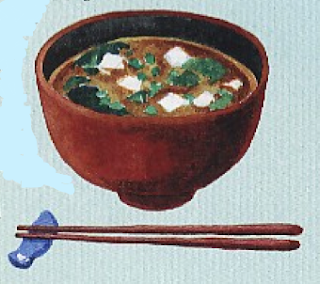 Illustration by Kazumi Wilds from THE WAKAME GATHERERSBe sure to order copies of this poetry anthology--perfect for schools, libraries, waiting rooms, and children's bookshelves. Thank you to National Geographic and J. Patrick Lewis and all the many contributing poets!
Illustration by Kazumi Wilds from THE WAKAME GATHERERSBe sure to order copies of this poetry anthology--perfect for schools, libraries, waiting rooms, and children's bookshelves. Thank you to National Geographic and J. Patrick Lewis and all the many contributing poets!<!-- /* Font Definitions */ @font-face {font-family:"Cambria Math"; panose-1:2 4 5 3 5 4 6 3 2 4; mso-font-charset:0; mso-generic-font-family:auto; mso-font-pitch:variable; mso-font-signature:-536870145 1107305727 0 0 415 0;} @font-face {font-family:"Yu Mincho"; panose-1:2 2 4 0 0 0 0 0 0 0; mso-font-charset:128; mso-generic-font-family:auto; mso-font-pitch:variable; mso-font-signature:-2147482905 717749503 18 0 131231 0;} @font-face {font-family:Calibri; panose-1:2 15 5 2 2 2 4 3 2 4; mso-font-charset:0; mso-generic-font-family:auto; mso-font-pitch:variable; mso-font-signature:-536870145 1073786111 1 0 415 0;} /* Style Definitions */ p.MsoNormal, li.MsoNormal, div.MsoNormal {mso-style-unhide:no; mso-style-qformat:yes; mso-style-parent:""; margin:0cm; margin-bottom:.0001pt; mso-pagination:widow-orphan; font-size:12.0pt; font-family:Calibri; mso-ascii-font-family:Calibri; mso-ascii-theme-font:minor-latin; mso-fareast-font-family:"Yu Mincho"; mso-fareast-theme-font:minor-fareast; mso-hansi-font-family:Calibri; mso-hansi-theme-font:minor-latin; mso-bidi-font-family:"Times New Roman"; mso-bidi-theme-font:minor-bidi;} .MsoChpDefault {mso-style-type:export-only; mso-default-props:yes; font-family:Calibri; mso-ascii-font-family:Calibri; mso-ascii-theme-font:minor-latin; mso-fareast-font-family:"Yu Mincho"; mso-fareast-theme-font:minor-fareast; mso-hansi-font-family:Calibri; mso-hansi-theme-font:minor-latin; mso-bidi-font-family:"Times New Roman"; mso-bidi-theme-font:minor-bidi;} @page WordSection1 {size:612.0pt 792.0pt; margin:72.0pt 72.0pt 72.0pt 72.0pt; mso-header-margin:36.0pt; mso-footer-margin:36.0pt; mso-paper-source:0;} div.WordSection1 {page:WordSection1;} </style> --></div>
Published on October 05, 2018 18:10
September 28, 2018
Moon Viewing
It's #PoetryFriday!
This week, September 24, was tsukimi 月見 (moon viewing) or jūgoyatsuki 十五夜月 (15th night moon) of the 8th lunisolar month--the full harvest moon. Serendipitously it was also the last day of the three-day higan (equinox) weekend.
For tsukimi, naturally we always hope for clear skies and plan to view the rising full moon.
Since this is the season when susuki (Japanese pampas grass) plumes "bloom" . . .
we set out decorations of susuki and seasonal flowers and offerings of harvest vegetables and tsukimi dango.

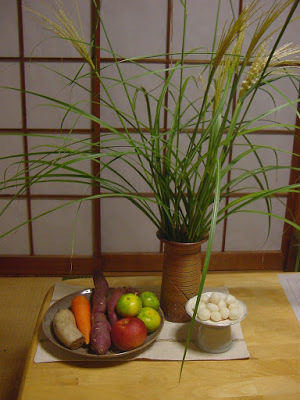 For dinner we might eat tsukimi udon or tsukimi soba or various round foods in honor of the moon. This year I made my own version of tsukimi soba with various toppings--instead of the egg yolk in the center, I opted for a moon of ground chicken. And dessert of a rabbit wagashi sweet.
For dinner we might eat tsukimi udon or tsukimi soba or various round foods in honor of the moon. This year I made my own version of tsukimi soba with various toppings--instead of the egg yolk in the center, I opted for a moon of ground chicken. And dessert of a rabbit wagashi sweet.
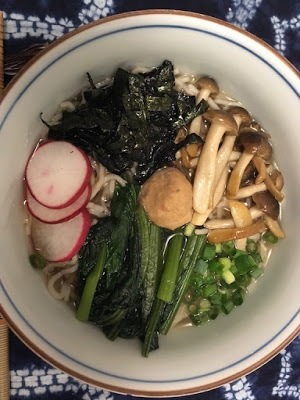
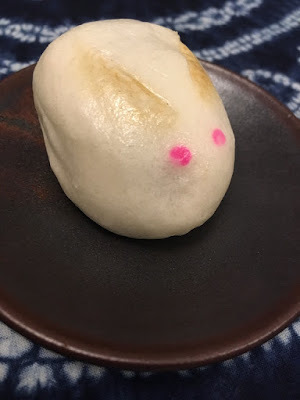
On tsukimi we might also read some moon books such as these on the shelves at Tokyo's Crayon House book store.
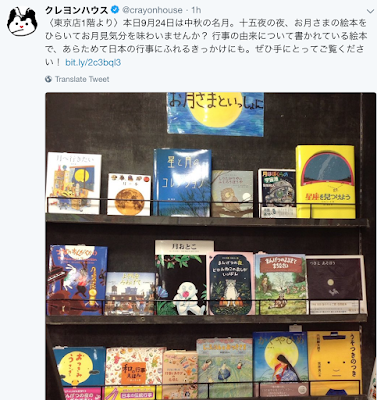 And we might hold moon viewing parties and compose poetry. This year we didn't hold a party, but we did turn our faces up to that perfect moon rising into the clear night sky. And I did compose a poem.
And we might hold moon viewing parties and compose poetry. This year we didn't hold a party, but we did turn our faces up to that perfect moon rising into the clear night sky. And I did compose a poem.
Tsukimi
some years you’re heavily draped in cloudsor shawled in mist, or you catch us off guard in autumn school and work weeks when we forget to gather susuki plumesand barely remember to glance up and search for your familiar face to whisper thanks
but this year you arrive on a holiday justmade for wading into your long low tidesand you climb the hills and peer throughtrees, teasing, before striding into the skybold, assured, in sync for now with our sun,our harvests, and our evened nights and days
All rights reserved © Holly Thompson 2018
For this week's Poetry Friday KidLit Round Up, visit the blog of Jone Rush McCulloch.
<!-- /* Font Definitions */ @font-face {font-family:"Cambria Math"; panose-1:2 4 5 3 5 4 6 3 2 4; mso-font-charset:0; mso-generic-font-family:auto; mso-font-pitch:variable; mso-font-signature:-536870145 1107305727 0 0 415 0;} @font-face {font-family:"Yu Mincho"; panose-1:2 2 4 0 0 0 0 0 0 0; mso-font-charset:128; mso-generic-font-family:auto; mso-font-pitch:variable; mso-font-signature:-2147482905 717749503 18 0 131231 0;} @font-face {font-family:Calibri; panose-1:2 15 5 2 2 2 4 3 2 4; mso-font-charset:0; mso-generic-font-family:auto; mso-font-pitch:variable; mso-font-signature:-536870145 1073786111 1 0 415 0;} /* Style Definitions */ p.MsoNormal, li.MsoNormal, div.MsoNormal {mso-style-unhide:no; mso-style-qformat:yes; mso-style-parent:""; margin:0cm; margin-bottom:.0001pt; mso-pagination:widow-orphan; font-size:12.0pt; font-family:Calibri; mso-ascii-font-family:Calibri; mso-ascii-theme-font:minor-latin; mso-fareast-font-family:"Yu Mincho"; mso-fareast-theme-font:minor-fareast; mso-hansi-font-family:Calibri; mso-hansi-theme-font:minor-latin; mso-bidi-font-family:"Times New Roman"; mso-bidi-theme-font:minor-bidi;} .MsoChpDefault {mso-style-type:export-only; mso-default-props:yes; font-family:Calibri; mso-ascii-font-family:Calibri; mso-ascii-theme-font:minor-latin; mso-fareast-font-family:"Yu Mincho"; mso-fareast-theme-font:minor-fareast; mso-hansi-font-family:Calibri; mso-hansi-theme-font:minor-latin; mso-bidi-font-family:"Times New Roman"; mso-bidi-theme-font:minor-bidi;} @page WordSection1 {size:612.0pt 792.0pt; margin:72.0pt 72.0pt 72.0pt 72.0pt; mso-header-margin:36.0pt; mso-footer-margin:36.0pt; mso-paper-source:0;} div.WordSection1 {page:WordSection1;} </style></div>-->
This week, September 24, was tsukimi 月見 (moon viewing) or jūgoyatsuki 十五夜月 (15th night moon) of the 8th lunisolar month--the full harvest moon. Serendipitously it was also the last day of the three-day higan (equinox) weekend.
For tsukimi, naturally we always hope for clear skies and plan to view the rising full moon.
Since this is the season when susuki (Japanese pampas grass) plumes "bloom" . . .
we set out decorations of susuki and seasonal flowers and offerings of harvest vegetables and tsukimi dango.

 For dinner we might eat tsukimi udon or tsukimi soba or various round foods in honor of the moon. This year I made my own version of tsukimi soba with various toppings--instead of the egg yolk in the center, I opted for a moon of ground chicken. And dessert of a rabbit wagashi sweet.
For dinner we might eat tsukimi udon or tsukimi soba or various round foods in honor of the moon. This year I made my own version of tsukimi soba with various toppings--instead of the egg yolk in the center, I opted for a moon of ground chicken. And dessert of a rabbit wagashi sweet.

On tsukimi we might also read some moon books such as these on the shelves at Tokyo's Crayon House book store.
 And we might hold moon viewing parties and compose poetry. This year we didn't hold a party, but we did turn our faces up to that perfect moon rising into the clear night sky. And I did compose a poem.
And we might hold moon viewing parties and compose poetry. This year we didn't hold a party, but we did turn our faces up to that perfect moon rising into the clear night sky. And I did compose a poem.Tsukimi
some years you’re heavily draped in cloudsor shawled in mist, or you catch us off guard in autumn school and work weeks when we forget to gather susuki plumesand barely remember to glance up and search for your familiar face to whisper thanks
but this year you arrive on a holiday justmade for wading into your long low tidesand you climb the hills and peer throughtrees, teasing, before striding into the skybold, assured, in sync for now with our sun,our harvests, and our evened nights and days
All rights reserved © Holly Thompson 2018
For this week's Poetry Friday KidLit Round Up, visit the blog of Jone Rush McCulloch.
<!-- /* Font Definitions */ @font-face {font-family:"Cambria Math"; panose-1:2 4 5 3 5 4 6 3 2 4; mso-font-charset:0; mso-generic-font-family:auto; mso-font-pitch:variable; mso-font-signature:-536870145 1107305727 0 0 415 0;} @font-face {font-family:"Yu Mincho"; panose-1:2 2 4 0 0 0 0 0 0 0; mso-font-charset:128; mso-generic-font-family:auto; mso-font-pitch:variable; mso-font-signature:-2147482905 717749503 18 0 131231 0;} @font-face {font-family:Calibri; panose-1:2 15 5 2 2 2 4 3 2 4; mso-font-charset:0; mso-generic-font-family:auto; mso-font-pitch:variable; mso-font-signature:-536870145 1073786111 1 0 415 0;} /* Style Definitions */ p.MsoNormal, li.MsoNormal, div.MsoNormal {mso-style-unhide:no; mso-style-qformat:yes; mso-style-parent:""; margin:0cm; margin-bottom:.0001pt; mso-pagination:widow-orphan; font-size:12.0pt; font-family:Calibri; mso-ascii-font-family:Calibri; mso-ascii-theme-font:minor-latin; mso-fareast-font-family:"Yu Mincho"; mso-fareast-theme-font:minor-fareast; mso-hansi-font-family:Calibri; mso-hansi-theme-font:minor-latin; mso-bidi-font-family:"Times New Roman"; mso-bidi-theme-font:minor-bidi;} .MsoChpDefault {mso-style-type:export-only; mso-default-props:yes; font-family:Calibri; mso-ascii-font-family:Calibri; mso-ascii-theme-font:minor-latin; mso-fareast-font-family:"Yu Mincho"; mso-fareast-theme-font:minor-fareast; mso-hansi-font-family:Calibri; mso-hansi-theme-font:minor-latin; mso-bidi-font-family:"Times New Roman"; mso-bidi-theme-font:minor-bidi;} @page WordSection1 {size:612.0pt 792.0pt; margin:72.0pt 72.0pt 72.0pt 72.0pt; mso-header-margin:36.0pt; mso-footer-margin:36.0pt; mso-paper-source:0;} div.WordSection1 {page:WordSection1;} </style></div>-->
Published on September 28, 2018 07:21
September 23, 2018
Orchards School Visit and PD
Recently I did an author visit at an international school in Tokyo where all Grade 8 students are assigned to read my verse novel Orchards over the summer in a unit titled Welcome Fires--a reference to the summer Obon motifs in the novel. At the start of the new school year in September, students began to craft short stories on the complexities and ambiguity of summer, and this year I joined the Grade 8s, gathering in a science lab, as they were beginning to revise their stories.
We did some collaborative writing, and I unraveled the process of creating one of my Obon scenes, and shared tactics and exercises I employ to revise scenes, stories and poems.
Questions from these Grade 8 students were excellent--how do you achieve ambiguity? how do you not over tell? how do you come up with motifs? how do you know what to revise? how do you choose images? why write in verse? how do you give a story layers? how do you make an experience into fiction?
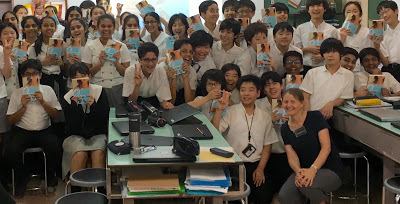
The student stories will be collected in a Welcome Fires anthology--I'm eager to receive my copy!
At the end of the day I led a PD session for teachers--Practices and Strategies for Cultivating Young Writers. We wrote to prompts, discovered writing prompts in poems, talked poetry and writing at schools, the importance of reading, storytelling, creative writing, and of a poem each and every day.
Interested in an author visit, workshop or PD session? See the Author Visits page on my website for details about all sorts of presentations!
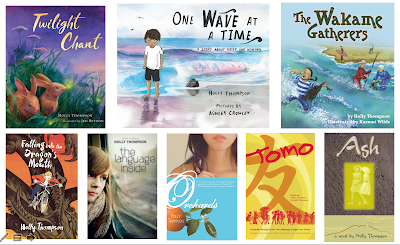
We did some collaborative writing, and I unraveled the process of creating one of my Obon scenes, and shared tactics and exercises I employ to revise scenes, stories and poems.
Questions from these Grade 8 students were excellent--how do you achieve ambiguity? how do you not over tell? how do you come up with motifs? how do you know what to revise? how do you choose images? why write in verse? how do you give a story layers? how do you make an experience into fiction?

The student stories will be collected in a Welcome Fires anthology--I'm eager to receive my copy!
At the end of the day I led a PD session for teachers--Practices and Strategies for Cultivating Young Writers. We wrote to prompts, discovered writing prompts in poems, talked poetry and writing at schools, the importance of reading, storytelling, creative writing, and of a poem each and every day.
Interested in an author visit, workshop or PD session? See the Author Visits page on my website for details about all sorts of presentations!

Published on September 23, 2018 23:25
August 28, 2018
GrubStreet Summer Picture Book Intensive
For the last few years, I've been teaching picture book courses at Boston's GrubStreet--6 Weeks, 6 Picture Books each spring, and in the summer a five-day Picture Book Intensive. This year I also developed and taught an online version of 6 Weeks, 6 Picture Books. All of these courses are generative courses for writers. We examine picture book anatomy, take close looks at heaps of picture books published within the last ten years, study the interplay of text and illustration, generate ideas for books in different picture book categories, write drafts, create storyboards and dummies, and we laugh and we cry, as it is when you discuss everything picture book related.
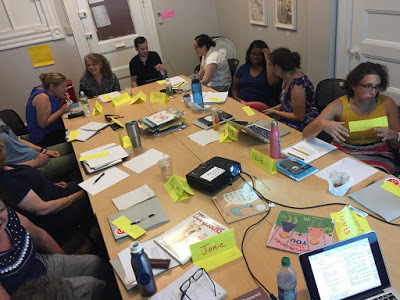 Grub Street Summer Picture Book Intensive
Grub Street Summer Picture Book Intensive
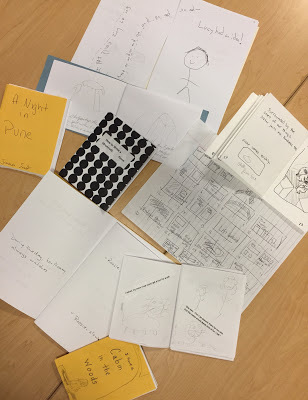 Storyboards and dummies by the summer Picture Book Intensive classFor each class I carry in heaps of picture books, and students bring in more. Because if you want to write picture books, you must read picture books. Tons of picture books. My selection of books changes significantly from course to course and the categories vary--in longer courses I usually separate STEM from History and Biography; add Social Justice and Peace to the Social Emotional and Learning; and include a Translations and Retellings category.
Storyboards and dummies by the summer Picture Book Intensive classFor each class I carry in heaps of picture books, and students bring in more. Because if you want to write picture books, you must read picture books. Tons of picture books. My selection of books changes significantly from course to course and the categories vary--in longer courses I usually separate STEM from History and Biography; add Social Justice and Peace to the Social Emotional and Learning; and include a Translations and Retellings category.
In the recent Grub Street summer Picture Book Intensive, we read and discussed some 100 picture books, most with separate authors and illustrators. So, here is the list of those titles that I managed to jot down--I did not manage to note all of the titles that students brought in. Some books fit into several categories and some were actually examined in more than one category, for example Pie is for Sharing and All the Way to Havana were included in both the narrative and poetry classes.
Grub Street Picture Book Intensive with Holly Thompson Summer 2018 books
NARRATIVE

• Windows by Julia Denos, ill. by E.B. Goodale
• Fish for Jimmy by Katie Yamasaki
• Accident by Andrea Tsurumi
• Jabari Jumps by Gaia Cornwall
• Flabbersmashed About You by Rachel Vail, ill. by Yumi Heo
• Pie is for Sharing by Stephanie Parsley Ledyard, ill. by Jason Chin
• All the Way to Havana by Margarita Engle, ill. by Mike Curato
• Drawn Together by Minh Lê, ill. by Dan Santat
• A Village is a Busy Place by Rehima Chitrakar, ill. by V. Geetha
• You Can’t Be Too Careful by Roger Mello, translated from the Portuguese by Daniel Hahn
• Let Me Finish by Minh Lê, ill. by Isabel Roxas
• The Field by Baptiste Paul, ill. by Jacqueline Alcantara
• A Different Pond by Bao Phi, ill. by Thi Bui
• Stay: A Girl, A Dog, A Bucket List by Kate Klise, ill. by M. Sarah Klise
• La Princesa and the Pea, by Susan Middleton Elya, ill. by Juana Martinez-Neal
• What Do You Do with an Idea? by Kobi Yamada, ill. by Mac Besom
• In Your Hands by Brian Pinkney
• Your Alien by Tammi Sauer, ill. by by Goro Fujita
• XO, Ox, A Love Story by Adam Rex, ill. by Scott Campbell
• A House that Once Was by Julie Fogliano, ill. by Lane Smith
• The Antlered Ship by Dashka Slater, ill. by The Fan Brothers
• Time to Pray by Maha Addasi, ill. by Gannon, Ned (bilingual—English and Arabic)
• Flowers for Sarajevo McCutcheon, John, ill. by Kristy Caldwell
• Ocean Meets Sky Fan Brothers
INFORMATIONAL—STEM, historical, biography

• Round by Joyce Sidman, ill. by Taeeun Yoo
• Honda The Boy Who Dreamed of Cars by Mark Weston, ill. by Katie Yamasaki
• Frida Kahlo and her Animalitos by Monica Brown, ill. by John Parra
• Schomburg, The Man Who Built a Library by Carole Boston Weatherford, ill. by Eric Velasquez
• Over and Under the Pond by Kate Messner, ill. by Christopher Silas Neal
• Flying Deep by Michelle Cusolito, ill. by Nicole Wong
• Mae Among the Stars, by Roda Ahmed, ill. by Stasia Burrington
• Bees, Snails, & Tails by Betsy Franco, ill. by Steve Jenkins
• George Gershwin Creates: Rhapsody in Blue by Suzanne Slade, ill. by Stacy Innerst
• Danza! Amalia Hernández and El Ballet Folklórico de Mexico by Duncan Tonatiuh
• Pride: The Story of Harvey Milk and the Rainbow Flag by Rob Sanders, ill. by Steven Salerno
• Girl Running: Bobbi Gibb and the Boston Marathon Annette Bay Pimentel, ill. by Micha Archer
• Yayoi Kusama: From Here to Eternity by Sarah Suzuki, ill. by Ellen Weinstein
• Fallingwater: The Building of Frank Lloyd Wright’s Masterpiece by Marc Harshman & Anna Egan Smucker, ill. by LeUyen Pham
• I Don’t Like Snakes by Nicola Davies, ill. by Luciano Lozano
• Moth & Wasp, Soil & Ocean: Remembering Chinese Scientist Pu Zhelong’s Work for Sustainable Farming by Sigrid Schmalzer, ill. Melanie Linden Chan
• I Dissent: Ruth Bader Ginsburg Makes Her Mark by Debbie Levy, ill. by Elizabeth Baddeley
• How to Code a Sandcastle by Josh Funk, ill. by Sara Palacios
POETRY

• A Kick in the Head: An Everyday Guide to Poetic Forms by Paul Janesko, ill. by Chris Raschka
• Slickety Quick: Poems about Sharks by Skila Brown, ill. by Bob Kolar
• Crown: An Ode to the Fresh Cut by Derrick Barnes, ill. by Gordon C. James
• LEAP! by JonArno Lawson, ill. by Josee Bisaillon
• A Greyhound, A Groundhog by Emily Jenkins, ill. by Chris Appelhans
• Sleep Train by Jonathan London, ill. by Lauren Eldridge
• Watersong by Tim McCanna, ill. by Richard Smythe
• Tony by Ed Galing, ill. by Erin E. Stead
• The Road Home by Katie Cotton, ill. by Sarah Jacoby
• Thunder Underground by Jane Yolen, ill. by Josee Masse
• Cricket in the Thicket by Carol Murray, ill. by Melissa Sweet
• Song of the Water Boatman & Other Pond Poems by Joyce Sidman, ill. by Beckie Prange
• What If . . . by Samatha Berger, ill. by Mike Curato
• Why am I me? by Paige Britt, ill. by Sean Qualls & Selina Alko
• How Do Dinosaurs Choose Their Pets by Jane Yolen, ill. by Mark Teague
• Things to Do by Elain Magliaro, ill. Catia Chien
SOCIAL AND EMOTIONAL LEARNING

• The Pond by Nicola Davies, ill. by Cathy Fisher
• When the Cousins Came by Katie Yamasaki
• Julian is a Mermaid by Jessica Love
• My Father’s Arms are a Boat by Stein Erik Lunde , ill. by Oyvind Torseter, translated from the Norwegian by Kari Dickson
• Where’s Rodney? by Carmen Bogan, ill. by Floyd Cooper
• Far Apart, Close in Heart: Being a Family When a Loved One is Incarcerated by Becky Birtha, ill. by Maja Kastelic
• Jerome by Heart by Thomas Scotto, ill. by Olivier Tallec
• Blue by Laura Vaccaro Seeger
HUMOR

• A Well-Mannered Young Wolf by Jean Leroy, ill. by Matthieu Maudet
• The Boss Baby by Marla Frazee
• My Dad is Big and Strong, But . . . by Coralie Savio, ill. by Kris Di Giacomo
• What! Cried Granny by Kate Lum, ill. by Adrian Johnson
• Don’t Let the Pigeon Drive the Bus! by Mo Willems
• When a Wolf is Hungry by Christine Naumann-Villemin, ill. by Kris Di Giacomo,
• Lion Lessons by Jon Agee
• How to Babysit a Grandpa by Jean Reagan, ill. by Lee Wildish
• Bawk & Roll by Tammi Sauer, ill. by Dan Santat
• The Dark by Lemony Snicket, ill. by Jon Klassen
• The Wolf, the Duck & the Mouse by Mac Barnett, ill. by Jon Klassen
Happy picture book reading!
 Grub Street Summer Picture Book Intensive
Grub Street Summer Picture Book Intensive
 Storyboards and dummies by the summer Picture Book Intensive classFor each class I carry in heaps of picture books, and students bring in more. Because if you want to write picture books, you must read picture books. Tons of picture books. My selection of books changes significantly from course to course and the categories vary--in longer courses I usually separate STEM from History and Biography; add Social Justice and Peace to the Social Emotional and Learning; and include a Translations and Retellings category.
Storyboards and dummies by the summer Picture Book Intensive classFor each class I carry in heaps of picture books, and students bring in more. Because if you want to write picture books, you must read picture books. Tons of picture books. My selection of books changes significantly from course to course and the categories vary--in longer courses I usually separate STEM from History and Biography; add Social Justice and Peace to the Social Emotional and Learning; and include a Translations and Retellings category.In the recent Grub Street summer Picture Book Intensive, we read and discussed some 100 picture books, most with separate authors and illustrators. So, here is the list of those titles that I managed to jot down--I did not manage to note all of the titles that students brought in. Some books fit into several categories and some were actually examined in more than one category, for example Pie is for Sharing and All the Way to Havana were included in both the narrative and poetry classes.
Grub Street Picture Book Intensive with Holly Thompson Summer 2018 books
NARRATIVE

• Windows by Julia Denos, ill. by E.B. Goodale
• Fish for Jimmy by Katie Yamasaki
• Accident by Andrea Tsurumi
• Jabari Jumps by Gaia Cornwall
• Flabbersmashed About You by Rachel Vail, ill. by Yumi Heo
• Pie is for Sharing by Stephanie Parsley Ledyard, ill. by Jason Chin
• All the Way to Havana by Margarita Engle, ill. by Mike Curato
• Drawn Together by Minh Lê, ill. by Dan Santat
• A Village is a Busy Place by Rehima Chitrakar, ill. by V. Geetha
• You Can’t Be Too Careful by Roger Mello, translated from the Portuguese by Daniel Hahn
• Let Me Finish by Minh Lê, ill. by Isabel Roxas
• The Field by Baptiste Paul, ill. by Jacqueline Alcantara
• A Different Pond by Bao Phi, ill. by Thi Bui
• Stay: A Girl, A Dog, A Bucket List by Kate Klise, ill. by M. Sarah Klise
• La Princesa and the Pea, by Susan Middleton Elya, ill. by Juana Martinez-Neal
• What Do You Do with an Idea? by Kobi Yamada, ill. by Mac Besom
• In Your Hands by Brian Pinkney
• Your Alien by Tammi Sauer, ill. by by Goro Fujita
• XO, Ox, A Love Story by Adam Rex, ill. by Scott Campbell
• A House that Once Was by Julie Fogliano, ill. by Lane Smith
• The Antlered Ship by Dashka Slater, ill. by The Fan Brothers
• Time to Pray by Maha Addasi, ill. by Gannon, Ned (bilingual—English and Arabic)
• Flowers for Sarajevo McCutcheon, John, ill. by Kristy Caldwell
• Ocean Meets Sky Fan Brothers
INFORMATIONAL—STEM, historical, biography

• Round by Joyce Sidman, ill. by Taeeun Yoo
• Honda The Boy Who Dreamed of Cars by Mark Weston, ill. by Katie Yamasaki
• Frida Kahlo and her Animalitos by Monica Brown, ill. by John Parra
• Schomburg, The Man Who Built a Library by Carole Boston Weatherford, ill. by Eric Velasquez
• Over and Under the Pond by Kate Messner, ill. by Christopher Silas Neal
• Flying Deep by Michelle Cusolito, ill. by Nicole Wong
• Mae Among the Stars, by Roda Ahmed, ill. by Stasia Burrington
• Bees, Snails, & Tails by Betsy Franco, ill. by Steve Jenkins
• George Gershwin Creates: Rhapsody in Blue by Suzanne Slade, ill. by Stacy Innerst
• Danza! Amalia Hernández and El Ballet Folklórico de Mexico by Duncan Tonatiuh
• Pride: The Story of Harvey Milk and the Rainbow Flag by Rob Sanders, ill. by Steven Salerno
• Girl Running: Bobbi Gibb and the Boston Marathon Annette Bay Pimentel, ill. by Micha Archer
• Yayoi Kusama: From Here to Eternity by Sarah Suzuki, ill. by Ellen Weinstein
• Fallingwater: The Building of Frank Lloyd Wright’s Masterpiece by Marc Harshman & Anna Egan Smucker, ill. by LeUyen Pham
• I Don’t Like Snakes by Nicola Davies, ill. by Luciano Lozano
• Moth & Wasp, Soil & Ocean: Remembering Chinese Scientist Pu Zhelong’s Work for Sustainable Farming by Sigrid Schmalzer, ill. Melanie Linden Chan
• I Dissent: Ruth Bader Ginsburg Makes Her Mark by Debbie Levy, ill. by Elizabeth Baddeley
• How to Code a Sandcastle by Josh Funk, ill. by Sara Palacios
POETRY

• A Kick in the Head: An Everyday Guide to Poetic Forms by Paul Janesko, ill. by Chris Raschka
• Slickety Quick: Poems about Sharks by Skila Brown, ill. by Bob Kolar
• Crown: An Ode to the Fresh Cut by Derrick Barnes, ill. by Gordon C. James
• LEAP! by JonArno Lawson, ill. by Josee Bisaillon
• A Greyhound, A Groundhog by Emily Jenkins, ill. by Chris Appelhans
• Sleep Train by Jonathan London, ill. by Lauren Eldridge
• Watersong by Tim McCanna, ill. by Richard Smythe
• Tony by Ed Galing, ill. by Erin E. Stead
• The Road Home by Katie Cotton, ill. by Sarah Jacoby
• Thunder Underground by Jane Yolen, ill. by Josee Masse
• Cricket in the Thicket by Carol Murray, ill. by Melissa Sweet
• Song of the Water Boatman & Other Pond Poems by Joyce Sidman, ill. by Beckie Prange
• What If . . . by Samatha Berger, ill. by Mike Curato
• Why am I me? by Paige Britt, ill. by Sean Qualls & Selina Alko
• How Do Dinosaurs Choose Their Pets by Jane Yolen, ill. by Mark Teague
• Things to Do by Elain Magliaro, ill. Catia Chien
SOCIAL AND EMOTIONAL LEARNING

• The Pond by Nicola Davies, ill. by Cathy Fisher
• When the Cousins Came by Katie Yamasaki
• Julian is a Mermaid by Jessica Love
• My Father’s Arms are a Boat by Stein Erik Lunde , ill. by Oyvind Torseter, translated from the Norwegian by Kari Dickson
• Where’s Rodney? by Carmen Bogan, ill. by Floyd Cooper
• Far Apart, Close in Heart: Being a Family When a Loved One is Incarcerated by Becky Birtha, ill. by Maja Kastelic
• Jerome by Heart by Thomas Scotto, ill. by Olivier Tallec
• Blue by Laura Vaccaro Seeger
HUMOR

• A Well-Mannered Young Wolf by Jean Leroy, ill. by Matthieu Maudet
• The Boss Baby by Marla Frazee
• My Dad is Big and Strong, But . . . by Coralie Savio, ill. by Kris Di Giacomo
• What! Cried Granny by Kate Lum, ill. by Adrian Johnson
• Don’t Let the Pigeon Drive the Bus! by Mo Willems
• When a Wolf is Hungry by Christine Naumann-Villemin, ill. by Kris Di Giacomo,
• Lion Lessons by Jon Agee
• How to Babysit a Grandpa by Jean Reagan, ill. by Lee Wildish
• Bawk & Roll by Tammi Sauer, ill. by Dan Santat
• The Dark by Lemony Snicket, ill. by Jon Klassen
• The Wolf, the Duck & the Mouse by Mac Barnett, ill. by Jon Klassen
Happy picture book reading!
Published on August 28, 2018 10:32
August 21, 2018
PW #SEL Booklist features ONE WAVE AT A TIME
I'm pleased to say that my picture book One Wave at a Time, illustrated by Ashley Crowley and published in April by Albert Whitman & Co., is featured in a recent Publishers Weekly "Social and Emotional Learning Booklist."

Author Shannon Maughan introduces the PW list:

I wrote One Wave at a Time especially for children, parents, siblings, friends, teachers, librarians and caregivers who have lost someone special or know someone who has. While the book targets the 4-8 age group, it is also intended for all ages. Sometimes simple lyrical writing can be a much-needed comfort at a difficult time. I'm so pleased that One Wave at a Time is featured in this list and especially hope that the book will be included in more school, community and bereavement group libraries. This Teacher's Guide also appears on my website. Thank you to publisher Albert Whitman & Co. for not shying away from publishing #SEL titles.
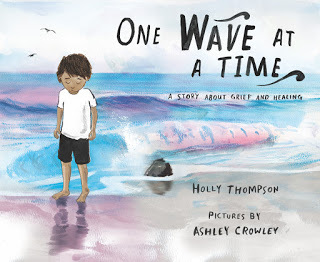
When I teach my GrubStreet picture book writing classes, I always include a focus on #SEL books.
And while I already know and love Katie Yamasaki's When the Cousins Came . . .
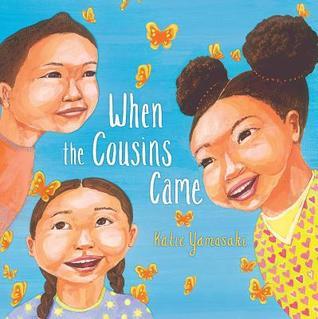
and Jessica Love's Julián is a Mermaid . . .
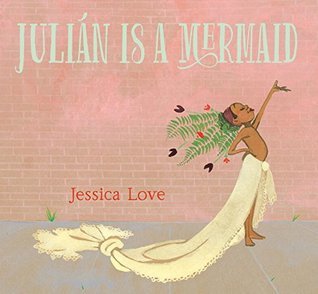
and Michael Ian Black's I'm Sad, illustrated by Debbie Ridpath Ohi , , ,
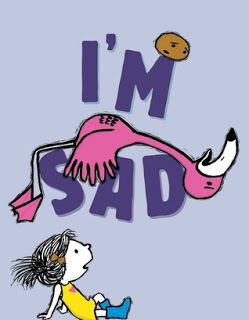
as well as a number of the other books on the list, I can't wait to read the rest. Social and Emotional Learning books for children are so vitally important! I'm so grateful for this PW list, and I look forward to checking out all of these #SEL titles.

Author Shannon Maughan introduces the PW list:
"We asked children’s book publishers to tell us about some of their more recent efforts to market and promote books that encompass social and emotional learning themes. In addition to sharing how they connect with educators, librarians, caregivers, and counselors, publishers also pointed to some of the top titles they’ve been spotlighting in this area, and we’ve compiled them as a resource list.
"Though there are surely many books focused on SEL themes—including some that are very well-known and loved—this list intentionally focuses on publishers’ most recent SEL-related titles."See the full PW Social and Emotional Booklist of over 60 titles--mostly picture books with a few MG and YA titles.

I wrote One Wave at a Time especially for children, parents, siblings, friends, teachers, librarians and caregivers who have lost someone special or know someone who has. While the book targets the 4-8 age group, it is also intended for all ages. Sometimes simple lyrical writing can be a much-needed comfort at a difficult time. I'm so pleased that One Wave at a Time is featured in this list and especially hope that the book will be included in more school, community and bereavement group libraries. This Teacher's Guide also appears on my website. Thank you to publisher Albert Whitman & Co. for not shying away from publishing #SEL titles.

When I teach my GrubStreet picture book writing classes, I always include a focus on #SEL books.
And while I already know and love Katie Yamasaki's When the Cousins Came . . .

and Jessica Love's Julián is a Mermaid . . .

and Michael Ian Black's I'm Sad, illustrated by Debbie Ridpath Ohi , , ,

as well as a number of the other books on the list, I can't wait to read the rest. Social and Emotional Learning books for children are so vitally important! I'm so grateful for this PW list, and I look forward to checking out all of these #SEL titles.
Published on August 21, 2018 11:09



